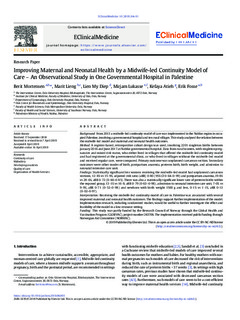| dc.contributor.author | Mortensen, Berit | |
| dc.contributor.author | Lieng, Marit | |
| dc.contributor.author | Diep, Lien My | |
| dc.contributor.author | Lukasse, Mirjam | |
| dc.contributor.author | Atieh, Kefaya | |
| dc.contributor.author | Fosse, Erik | |
| dc.date.accessioned | 2019-08-06T10:44:23Z | |
| dc.date.available | 2019-08-06T10:44:23Z | |
| dc.date.created | 2019-07-11T11:00:26Z | |
| dc.date.issued | 2019 | |
| dc.identifier.citation | EClinicalMedicine. 2019, 10, 84-91. | nb_NO |
| dc.identifier.issn | 2589-5370 | |
| dc.identifier.uri | http://hdl.handle.net/11250/2607283 | |
| dc.description | This is an open access article under the CC BY-NC-ND license | nb_NO |
| dc.description.abstract | Background:
From 2013 a midwife-led continuity model of care was implemented in the Nablus region in occupied Palestine, involving a governmental hospital and ten rural villages. This study analysed the relation between the midwife-led model and maternal and neonatal health outcomes.
Method:
A register-based, retrospective cohort design was used, involving 2201 singleton births between January 2016 and June 2017 at Nablus governmental hospital. Data from rural women, with singleton pregnancies and mixed risk status, who either lived in villages that offered the midwife-led continuity model and had registered at the governmental clinic, or who lived in villages without the midwife-led model and received regular care, were compared. Primary outcome was unplanned caesarean section. Secondary outcomes were other modes of birth, postpartum anaemia, preterm birth, birth weight, and admission to neonatal intensive care unit.
Findings:
Statistically significant less women receiving the midwife-led model had unplanned caesarean sections, 12·8% vs 15·9%, adjusted risk ratio (aRR) 0·80 (95% CI 0·64–0·99) and postpartum anaemia,19·8% vs 28·6%, aRR 0·72 (0·60–0·85). There was also a statistically significant lower rate of preterm births within the exposed group, 13·1% vs 16·8, aRR 0·79 (0·63–0·98), admission to neonatal intensive care unit, 7·0% vs 9·9%, aRR 0·71 (0·52–0·98) and newborn with birth weight 1500 g and less, 0·1% vs 1·1%, aRR 0·13 (0·02–0·97).
Interpretation:
Receiving the midwife-led continuity model of care in Palestine was associated with several improved maternal and neonatal health outcomes. The findings support further implementation of the model. Implementation research, including randomised studies, would be useful to further investigate the effect and feasibility of the model in a low resource setting. | nb_NO |
| dc.description.sponsorship | This study was partly funded by the Research Council of Norway through the Global Health and Vaccination Program (GLOBVAC), project number 243706. The implementation received public funding through Norwegian Aid Committee (NORWAC). | nb_NO |
| dc.language.iso | eng | nb_NO |
| dc.rights | Attribution-NonCommercial-NoDerivatives 4.0 Internasjonal | * |
| dc.rights.uri | http://creativecommons.org/licenses/by-nc-nd/4.0/deed.no | * |
| dc.title | Improving Maternal and Neonatal Health by a Midwife-led Continuity Model of Care ? An Observational Study in One Governmental Hospital in Palestine | nb_NO |
| dc.type | Journal article | nb_NO |
| dc.type | Peer reviewed | nb_NO |
| dc.description.version | publishedVersion | nb_NO |
| dc.rights.holder | (c) 2019 Published by Elsevier Ltd. | nb_NO |
| dc.source.pagenumber | 84-91 | nb_NO |
| dc.source.volume | 10 | nb_NO |
| dc.source.journal | EClinicalMedicine | nb_NO |
| dc.identifier.doi | 10.1016/j.eclinm.2019.04.003 | |
| dc.identifier.cristin | 1711222 | |
| cristin.unitcode | 222,56,0,0 | |
| cristin.unitname | Fakultet for helse- og sosialvitenskap | |
| cristin.ispublished | true | |
| cristin.fulltext | original | |
| cristin.qualitycode | 1 | |

